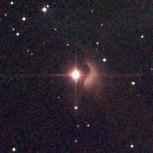







| BOOKS | F. A. Q. | ARTICLES | TALKS | ABOUT KEN | DONATE | BEYOND OUR KEN |
|---|

By Ken Croswell
Image obtained as part of the Two Micron All Sky Survey (2MASS), a joint project of the University of Massachusetts and the Infrared Processing and Analysis Center/California Institute of Technology, funded by the National Aeronautics and Space Administration and the National Science Foundation
Published on Astronomy.com (January 7, 2005).
For the first time, astronomers in Mexico and the United States have determined the precise distance to the young star T Tauri. The newly measured parallax places the star about 460 light-years from Earth, in line with previous but less direct estimates.
T Tauri is the prototype for a class of newborn stars. Unlike the Sun and other main-sequence stars, which generate light by converting hydrogen into helium at their cores, T Tauri stars shine by tapping the force of gravity. As gravity squeezes the stars, they heat up and glow. In the same way, gravity causes water to fall over a dam and generate electricity. Someday the stars will initiate nuclear fusion and become main-sequence stars like the Sun.
Laurent Loinard of the National Autonomous University of Mexico in Morelia and his colleagues used the Very Long Baseline Array to observe T Tauri's radio waves. T Tauri consists of at least three stars, one that shines in visible light and two that glow at infrared wavelengths. The radio waves come from one of the infrared stars.
Loinard's team observed the star from September 2003 to September 2004. During that year, as Earth orbited the Sun, the astronomers viewed the star from slightly different perspectives. This caused the star's apparent position to shift. The larger the shift, or parallax, the closer the star is to Earth.
As Loinard's team will report in an upcoming issue of Astrophysical Journal Letters, T Tauri is 462 ± 9 light-years from Earth. This result is far more precise than any previous parallax for the star. For example, the distance the Hipparcos satellite determined for T Tauri had an uncertainty of more than 100 light-years. And the star's negative parallax in the 1995 edition of The General Catalogue of Trigonometric Stellar Parallaxes is useless.
Taurus and neighboring Auriga abound with young stars, but T Tauri is only the second T Tauri star in Taurus with a precisely measured parallax. The first, named V773 Tauri, has a distance of 484 ± 18 light-years. The similarity between the two stars' distances suggests all the T Tauri stars in Taurus reside about equally far from Earth. In contrast, the much cruder Hipparcos parallaxes hinted the two stars might be separated by more than 200 light-years.
"It's a nice confirmation of the distance to the Taurus complex," says Steven Stahler, a star-formation expert at the University of California at Berkeley. "The distance to that particular star is not so earthshaking as the distance to the group, which is more interesting, because that leads to accurate luminosities of the stars." Knowing the stars' distance, astronomers can convert their apparent brightnesses into luminosities--how much light the stars emit into space. The luminosities and temperatures of T Tauri stars reveal their ages, so knowing the distance helps astronomers discern how star formation proceeded across Taurus.
T Tauri itself is a 10th-magnitude star about 4 degrees northwest of Aldebaran, the brightest star in Taurus. The young star illuminates a small nebula to its west, which may be leftover material from its birth. Both the star and nebula vary in brightness. Indeed, it was the star's variability that caught the eye of its discoverer, English astronomer John Russell Hind, in 1852.
T Tauri is only about a million years old. If the Sun were a 40-year-old man, T Tauri would be a 3-day-old infant. Shortly after its birth, the Sun was a T Tauri star itself, showering Earth with light produced by gravitational power.
Update (August 15, 2007): In work to appear in The Astrophysical Journal, Loinard's team reports an even more precise distance for T Tauri: 481 ± 2 light-years.
Ken Croswell is an astronomer in Berkeley, California, and the author of Magnificent Universe and Magnificent Mars.
"Elegant and eloquent"--Washington Post. See all reviews of Magnificent Universe here.
| BOOKS | F. A. Q. | ARTICLES | TALKS | ABOUT KEN | DONATE | BEYOND OUR KEN |
|---|